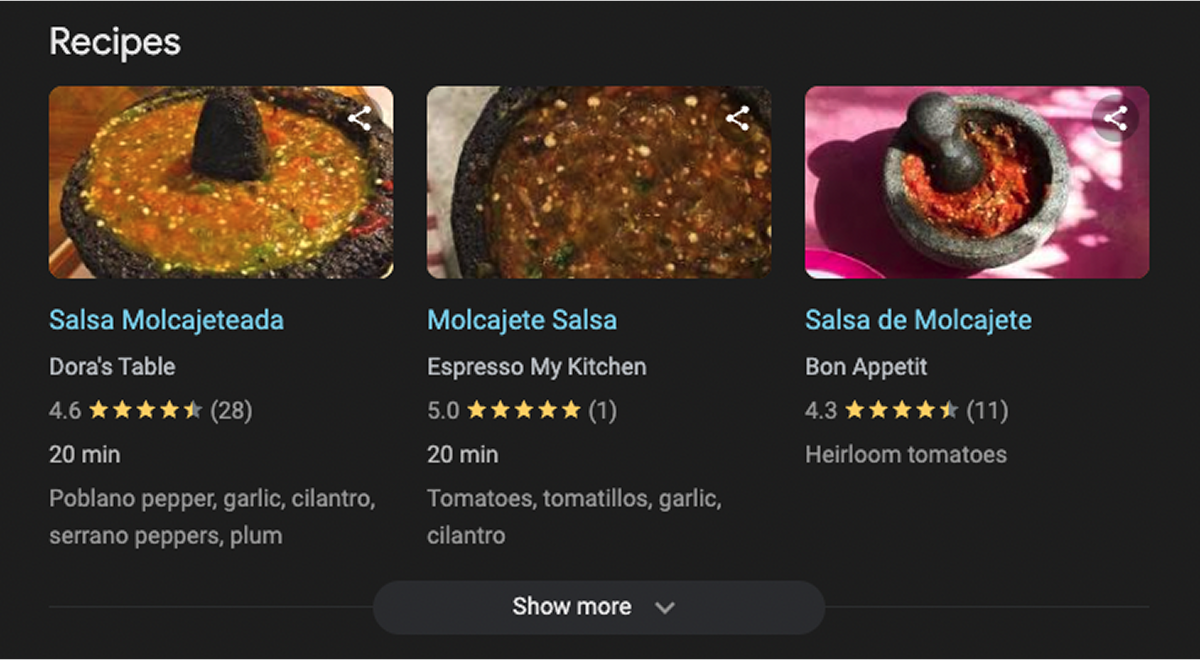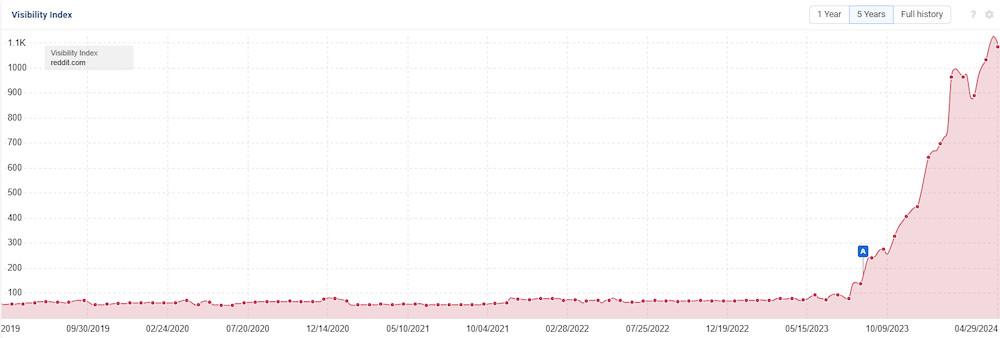
By now, it’s common to see Reddit threads ranking high in Google search results – and that’s no accident.
People increasingly want answers from other people:
- Advice.
- Inspiration.
- Real experiences.
- Unfiltered recommendations.
Forums meet that demand, but they’re just one piece of a much bigger puzzle.
As Google continues to evolve, user-generated content (UGC) is becoming more central to the search experience – and smart brands are taking notice.
Many are already leveraging UGC to gain a more authentic edge in organic search and strengthen their overall marketing performance.
But why does UGC work so well for SEO – and how, exactly?
This article:
- Connects the dots using Google’s own framework for helpful, reliable, people-first content.
- Explores creative, practical ways brands can use UGC to elevate visibility and engagement.
Why does Google care about UGC?
Reddit’s sudden search dominance might have felt like the flip of a switch (it sure looked like one on a graph).
But that’s no more the case than it is with the AI Overview.
We’d been moving toward both for a while, competition just proved to be a strong catalyst.

Today, non-Google platforms offer improved experiences for finding information in certain contexts.
Often, those experiences do a better job of meeting user expectations.
One of the most well-known statistics related to this is from a 2022 presentation by Prabhakar Raghavan at Fortune’s Brainstorm Tech conference:
- “In our studies, something like almost 40% of young people, when they’re looking for a place for lunch, they don’t go to Google Maps or Search… They go to TikTok or Instagram.”
Just the year before, Google had already begun experimenting with TikTok and Instagram results in search.
Since 2023, Reddit has been all over SERPs.
We should expect the evolution to continue in a similar direction, with Google bringing UGC into the fold in increasingly prominent and visual ways.
Dig deeper: Advanced tactics to maximize the SEO value of user-generated content
As user expectations evolve, Google does, too
The growing prevalence of UGC as a part of the search experience is part of Google’s perennial efforts to:
- Give people the most helpful answers to their queries.
- Serve information in the experience that best meets their expectations.
The target is always moving, and Google needs to get as close as it can to hitting it or risk losing its dominance.
Google is prioritizing UGC more and more because, in many cases, it’s the best bet for hitting that target.
Or at minimum, Google is making an enormous bet that this is the case.
After all, who knows what people want more than the people themselves?
In the same way, brands that focus on tailoring content for people, rather than the current moment in SEO, are going to win in the long run.
New queries
New queries are popping up every day.
Up to 15% of search queries are new, whereas the content that brands create is largely reactive.
Most of it is published only after there’s an indication that people care. That means there’s a publishing lag by nature.
Take keyword research. Traditionally, content is created once keyword research shows queries with search volume. By then, people had long been looking for the information.
For Google, UGC content is a source of information gain – fresh perspectives and information that are prioritized in search to offer new answers for previously unused queries and longstanding search phrases alike.
User-friendly formats
Users consume media and information differently than they did just a decade ago.
In the same speech from 2022, Raghavan notes that Google Maps is designed to resemble a paper map, but the vast majority of today’s youth haven’t interacted with one.
For Google, UGC is a way of bringing people’s preferred learning and research formats to the forefront of the search experience.
Like, say, recipes.
Maybe I want to use the molcajete I was gifted last year to make some salsa, so I search Google for “molcajete salsa recipe.”
The SERP will give me different options in different featured placements.
I’ll find a grid of results from recipe blogs at the top.

I’ll also find a section of Reddit threads and short videos just below.

At this point, it’s a bit of a running joke how recipe blogs have tried to gamify SEO.
Most recipes start with a novella of relatively useless information that users have to scroll through to get the recipe.
So, honestly, which is more useful?
Scrolling down the page of this popular blog to finally find the recipe below.

Or watching this minute-long YouTube Short?

I’m a millennial, but I’ll still choose the TikTok tutorial. It’s just a better user experience.
Plus, this type of content can easily be repurposed.
The video’s creator, Chef José, has the same video on TikTok (~341,000 likes, ~80,000 saves) and YouTube Shorts (1,300,000 likes and 6,000 comments).
Talk about getting the most out of your content!
As a brand, this type of format can be the hero of pages on your site and a strong performer on platforms like YouTube and TikTok.
By using UGC this way, a domain gives itself three solid opportunities and platforms to gain visibility for a competitive term.
Dig deeper: Why creator-led content marketing is the new standard in search
UGC and the helpful content framework
- “Google’s automated ranking systems are designed to present helpful, reliable information that’s primarily created to benefit people, not to gain search engine rankings, in the top Search results.”
Those words open Google’s documentation on creating content that performs well in search, “Creating Helpful, Reliable, People-First Content.”
UGC works across each of those three pillars.
Helpful
UGC is helpful in a way brands can’t quite replicate otherwise.
An example I like to use is product images on a description page.
Photos from real people are powerful in a way that studio product photography can’t replicate authentically.
The clean, crisp images we see on product landing pages serve an important purpose.
They help users understand and desire a product or service and allow them to see details clearly from many angles.
Whereas, UGC photos help people gauge how well products fit into their lives and meet their needs.
For example, if you go to Adidas, Finish Line, or Nordstrom, you’ll find variations of the same images below for these Adidas Samba sneakers.

But only on one of those sites, Nordstrom, can you find an image of someone wearing the same shoes in real life.
It’s the only one of the three domains that collects and publishes images as an optional piece of the review.


Images of the shoes out in the wild serve original, contextual, and visual information to the product page, which would otherwise share much of the same product information and imagery across all three sites.
Based on these in-real-life “lifestyle” images, I can tell how these Sambas look on someone’s foot, what shade of brown they are in real life, and how they look with some dark pants.
I can also gauge if the aesthetics – or dare I say, “vibes” – align with the look I’m aiming for. It brings authentic, helpful information to the table, letting users imagine their life in their shoes.
Brands should take this type of imagery, infuse it into the search experience, and test results.
That could mean specifying UGC imagery as additional images in product schema, open graph image, or part of the product carousel to potentially improve clicks and conversion.
Going further, could using UGC images on product category pages encourage more clickthrough and, in turn, drive down bounce rate?
Reliable
Today, a majority of product searches in the U.S. start on Amazon, not Google.
People know they’ll find a lot of product feedback from other people, including reviews and Q&A.
This is important because 98% of people say that reviews are essential when making a purchase decision.
Obviously, a brand’s review of its own product will be met with some scrutiny.
That’s why reviews exist in the first place! They create confidence that can only come from word-of-mouth.
In a similar way, UGC can help bolster reliability from an SEO perspective by improving E-E-A-T: an important set of guidelines for understanding what makes content – and brand domains – trustworthy.
In particular, UGC can do a lot to support experience (E) and trust (T).
Reviews and UGC backlinks from external sites can:
- Boost authority.
- Share authentic experiences.
- Instill confidence.
That’s especially important for brands that sell expensive products, as 78% of people say the more expensive the product, the more they read reviews.
The reviews that people trust most aren’t always on the brand’s site.
For instance, this user turned to the Reddit community for insights before purchasing an expensive indoor garden setup.

They got some honest and helpful feedback.


As a brand, spurring these types of conversations brings some of the same benefits as good PR, but with the power of word-of-mouth recommendations.
Most brands have a press page, why not have a word-of-mouth counterpart?
- Collect posts, threads, and reviews.
- Put them in front of users to be even more transparent.
It will help Google find even more reasons to gauge your site as trustworthy.
People-first
You could argue that UGC is people-first by nature, for any of the reasons we’ve already talked about.
But UGC isn’t just a source of people-first content, it’s also a source of data about what people really want.
Tapping into that data can prove a key differentiator that helps infuse a people-first mentality into not just the content you create, but how you create it in the first place.
Look into:
- Internal and external reviews.
- Social media posts.
- Search data.
- Forum conversations.
These sources contain valuable information about what people really want from products, services, and information.
At scale, that data is ripe with consumer insights that can be applied across a site to engage users, build trust, and communicate value.
Much of this data is available to brands through first-party reviews, platform APIs, and third-party tools.
Using a digital market intelligence methodology to aggregate and analyze this kind of data can yield rich information, such as:
- Trending topics.
- Product use cases.
- Which formats engage users for which purposes.
Here’s one quick example to make the point.
A lot of websites have functionality that allows users to vote whether reviews are helpful or not.
The Brooklinen sheet bundle below has a whopping ~23,000 reviews – that’s a boatload of data!

Within that data, the reviews that are voted most helpful are likely to offer insights as to useful information that’s not currently in the product description.
By pulling all of the reviews for this product above a certain threshold of likes, we could narrow the data set.
Then, use machine learning to quickly identify patterns.

The most prevalent patterns would likely represent information that should be prioritized on the landing page because it’s helpful to users.
In turn, creating a more helpful landing page would make it more SEO-friendly, based on Google’s own guidelines for great content.
Dig deeper: Writing people-first content: A process and template
Help your users by letting them help you
By building a way for people to create content for you and a strategy for how you’ll use it to help users, you’re also building for the future of SEO.
Because at the end of the day, Google’s goal is the same as most brands – give people what they want, so that they keep coming back.

